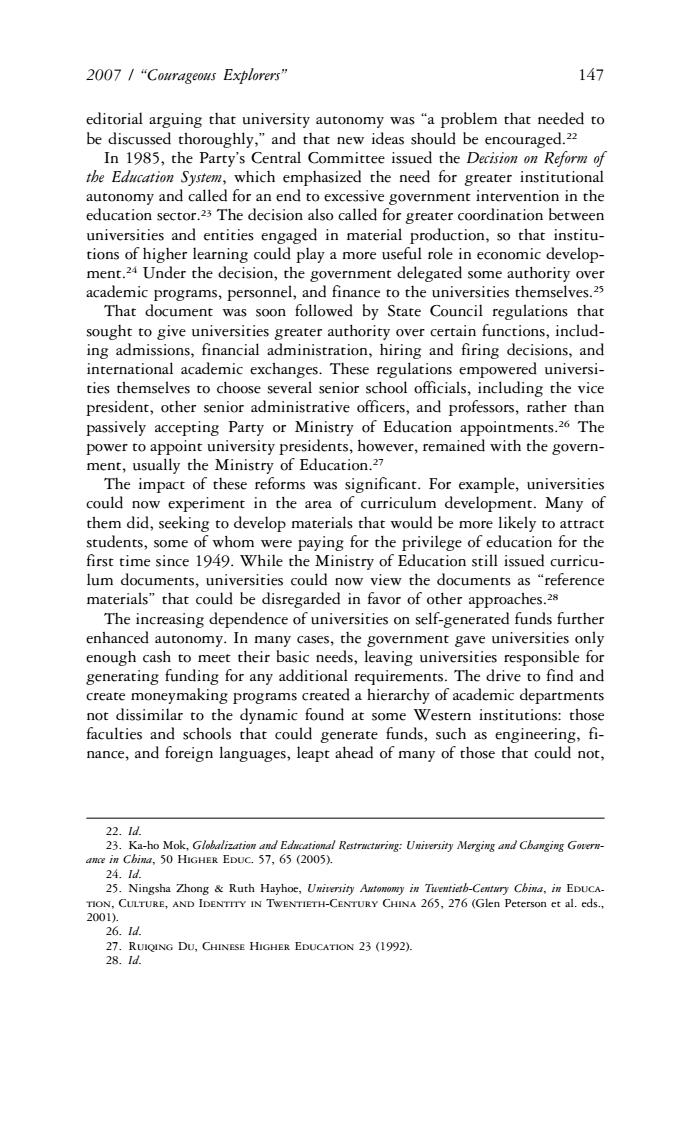正在加载图片...

2007/“Courageous Explorers” 147 editorial arguing that university autonomy was "a problem that needed to be discussed thoroughly,"and that new ideas should be encouraged.2 In 1985,the Party's Central Committee issued the Decision on Reform of the Education System,which emphasized the need for greater institutional autonomy and called for an end to excessive government intervention in the education sector.23 The decision also called for greater coordination between universities and entities engaged in material production,so that institu- tions of higher learning could play a more useful role in economic develop- ment.24 Under the decision,the government delegated some authority over academic programs,personnel,and finance to the universities themselves.25 That document was soon followed by State Council regulations that sought to give universities greater authority over certain functions,includ- ing admissions,financial administration,hiring and firing decisions,and international academic exchanges.These regulations empowered universi- ties themselves to choose several senior school officials,including the vice president,other senior administrative officers,and professors,rather than passively accepting Party or Ministry of Education appointments.26 The power to appoint university presidents,however,remained with the govern- ment,usually the Ministry of Education.27 The impact of these reforms was significant.For example,universities could now experiment in the area of curriculum development.Many of them did,seeking to develop materials that would be more likely to attract students,some of whom were paying for the privilege of education for the first time since 1949.While the Ministry of Education still issued curricu- lum documents,universities could now view the documents as "reference materials"that could be disregarded in favor of other approaches.28 The increasing dependence of universities on self-generated funds further enhanced autonomy.In many cases,the government gave universities only enough cash to meet their basic needs,leaving universities responsible for generating funding for any additional requirements.The drive to find and create moneymaking programs created a hierarchy of academic departments not dissimilar to the dynamic found at some Western institutions:those faculties and schools that could generate funds,such as engineering,fi- nance,and foreign languages,leapt ahead of many of those that could not, 22.1d. 23.Ka-ho Mok,Globalization and Edncational Restructuring:University Merging and Changing Govern- ame in Cbind,50 HIGHER EDUC.57,65 (2005). 24.1d. 25.Ningsha Zhong Ruth Hayhoe,University Automomy in Ticentieth-Century China,in EDUCA. TION,CULTURE,AND IDENTITY IN TWENTIETH-CENTURY CHINA 265,276(Glen Peterson et al.eds., 2001). 26.1d. 27.RUIQING DU,CHINESE HIGHER EDUCATION 23(1992). 28.1d.\\server05\productn\H\HLH\20\HLH2001.txt unknown Seq: 7 12-JUN-07 16:27 2007 / “Courageous Explorers” 147 editorial arguing that university autonomy was “a problem that needed to be discussed thoroughly,” and that new ideas should be encouraged.22 In 1985, the Party’s Central Committee issued the Decision on Reform of the Education System, which emphasized the need for greater institutional autonomy and called for an end to excessive government intervention in the education sector.23 The decision also called for greater coordination between universities and entities engaged in material production, so that institutions of higher learning could play a more useful role in economic development.24 Under the decision, the government delegated some authority over academic programs, personnel, and finance to the universities themselves.25 That document was soon followed by State Council regulations that sought to give universities greater authority over certain functions, including admissions, financial administration, hiring and firing decisions, and international academic exchanges. These regulations empowered universities themselves to choose several senior school officials, including the vice president, other senior administrative officers, and professors, rather than passively accepting Party or Ministry of Education appointments.26 The power to appoint university presidents, however, remained with the government, usually the Ministry of Education.27 The impact of these reforms was significant. For example, universities could now experiment in the area of curriculum development. Many of them did, seeking to develop materials that would be more likely to attract students, some of whom were paying for the privilege of education for the first time since 1949. While the Ministry of Education still issued curriculum documents, universities could now view the documents as “reference materials” that could be disregarded in favor of other approaches.28 The increasing dependence of universities on self-generated funds further enhanced autonomy. In many cases, the government gave universities only enough cash to meet their basic needs, leaving universities responsible for generating funding for any additional requirements. The drive to find and create moneymaking programs created a hierarchy of academic departments not dissimilar to the dynamic found at some Western institutions: those faculties and schools that could generate funds, such as engineering, finance, and foreign languages, leapt ahead of many of those that could not, 22. Id. 23. Ka-ho Mok, Globalization and Educational Restructuring: University Merging and Changing Governance in China, 50 HIGHER EDUC. 57, 65 (2005). 24. Id. 25. Ningsha Zhong & Ruth Hayhoe, University Autonomy in Twentieth-Century China, in EDUCATION, CULTURE, AND IDENTITY IN TWENTIETH-CENTURY CHINA 265, 276 (Glen Peterson et al. eds., 2001). 26. Id. 27. RUIQING DU, CHINESE HIGHER EDUCATION 23 (1992). 28. Id